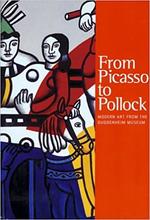Marc Chagall was an escape artist – he escaped Nazi occupied France and he was an artist.
The Nazi’s were bitter about how good an escape artist he was. Maybe they were jealous of his ability to paint something other than German realist portraiture. They republished an essay of praise, twisting the words to mock his work as “green, purple, and red Jews shooting out of the earth, fiddling on violins, flying through the air.” The highly nuanced review of Chagall’s work takes a bigoted turn after that, but up until that point they were more or less spot on.
Paris Through the Window is one of those fairytales that you love as a kid (look at those whimsical colors in the window pane, fun!). But when you get a little older the Hasidic couple stuck sideways, the un-dead sinner cat, and the two-faced man full of regret start to remind you that fairytales make life’s endless disappointments seem normal and it seems kind of messed up to show it to kids.
Apart from being dark and sad, Chagall was also sappy AF. He said things like “In our life there is a single color…It is the color of love.” It’s probably why Picasso didn’t like him that much. Still, Picasso called Chagall the second best color guy, after Matisse, duh.
He loved his colors but had no interest in keeping it real. André Breton took note of Chagall’s nonexistent loyalty to reality in his work during this period and tried to convince the painter to join Breton’s booby-baring publication La Révolution surréaliste. This one breaks enough of Newton’s laws to be surreal, for sure; the cat is literally the only thing touching the ground. But Chagall wasn’t about to be pigeonholed into surrealism and straight-up refused to let Breton use his work.
Chagall’s friend/idol Guillaume Apollinaire also tried to generalize his work as surrealism. Chagall responded by painting Apollinaire as Adam and Eve sharing one set of legs and with no private parts at all. Like, “thanks.”
The only –ism for Chagall was Judaism.
















Not my favorite chagall piece.